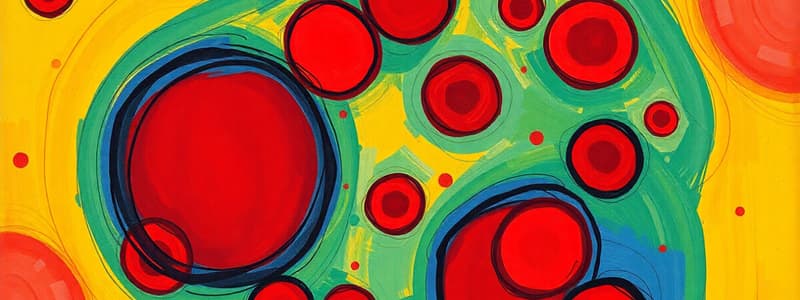Podcast
Questions and Answers
Which of the following inclusions is specifically associated with Glucose-6-Phosphate Dehydrogenase deficiency?
Which of the following inclusions is specifically associated with Glucose-6-Phosphate Dehydrogenase deficiency?
- Howell-Jolly Bodies
- Heinz Bodies (correct)
- Cabot Rings
- Hb H Inclusion Bodies
What is the shape and staining characteristic of Cabot Rings?
What is the shape and staining characteristic of Cabot Rings?
- Round and red with Wright stain
- Small, multiple blue-red inclusions
- Threadlike purple-blue loops or rings (correct)
- Irregular, colorless structures
Which stain would you use to observe Hb H inclusion bodies?
Which stain would you use to observe Hb H inclusion bodies?
- Papanicolaou stain
- Wright stain
- Supravital stain (correct)
- Gram stain
Which diseases are Howell-Jolly Bodies most commonly associated with?
Which diseases are Howell-Jolly Bodies most commonly associated with?
Which hemoglobin variant is related to abnormal hemoglobin composed of 4 beta globin chains?
Which hemoglobin variant is related to abnormal hemoglobin composed of 4 beta globin chains?
Flashcards
Howell-Jolly bodies
Howell-Jolly bodies
Small, round, blue to purple inclusion bodies in RBCs; typically found after splenectomy or in megaloblastic anemias.
Cabot rings
Cabot rings
Threadlike, purplish-blue loops or rings within red blood cells; often associated with megaloblastic anemias or certain types of anemia.
Heinz bodies
Heinz bodies
Small, round, blue inclusions in red blood cells; visible using supravital stains, not Wright stain. Usually associated with G6PD deficiency, some drug-induced anemias, and unstable hemoglobin disease.
Hb H inclusion bodies
Hb H inclusion bodies
Signup and view all the flashcards
Mittic spindle remnants
Mittic spindle remnants
Signup and view all the flashcards
Precipitated Hb H
Precipitated Hb H
Signup and view all the flashcards
Hb Variants
Hb Variants
Signup and view all the flashcards
Wright stain
Wright stain
Signup and view all the flashcards
Study Notes
Howell-Jolly Bodies
- Appear singly in a cell
- Usually round, less than 1 µm in diameter
- Blue to purple in color
- Remnants of nuclear chromatin (DNA)
- Demonstrated by Wright stain
- Associated with megaloblastic anemias, after splenectomy, and thalassemia
Cabot Rings
- Described as threadlike structures
- Appear as purple-blue loops or rings
- Mitotic spindle remnants
- Detected using Wright stain
- Associated with megaloblastic anemias, refractory anemia, and lead poisoning
Heinz Bodies
- Eccentrically located along the inner RBC membrane
- Appear large, round, and blue to purple
- Denatured and precipitated hemoglobin
- Not demonstrated by Wright stain; may dissolve in stain
- Can be mistaken for other inclusions
- Detected with supravital stains (e.g., BCB, NMB, crystal violet, methyl violet)
Hb H Inclusion Bodies
- Small, multiple, and evenly distributed throughout
- Precipitated Hb H (abnormal Hb composed of 4 beta globin chains/denatured beta-globin chains)
- Detected with supravital stains (e.g., NMB, BCP, Oil red O, methyl violet)
- Associated with Hb H disease (a subtype of alpha thalassemia)
Unstable Hemoglobin Variants
- Examples: Hb Köln, Hb Casper/Southampton, Hb Genova, Hb Gun Hill, Hb M-Saskatoon, Hb Bristol, Hb Torino, Hb Seattle
- Associated with unstable hemoglobin disease (congenital Heinz body hemolytic anemia)
Glucose-6-Phosphate Dehydrogenase (G6PD) Deficiency
- Favism (sensitivity to fava beans), unusual
- Occurs mainly in people of Mediterranean origin and in Chinese
- May result in severe hemolytic episode(s)
- Associated with drug-induced hemolytic anemia
Studying That Suits You
Use AI to generate personalized quizzes and flashcards to suit your learning preferences.
Description
Test your knowledge on various blood cell inclusions such as Howell-Jolly bodies, Cabot rings, Heinz bodies, and Hb H inclusion bodies. This quiz covers their appearance, staining methods, and associations with different anemias and conditions. It's crucial for students in hematology and related fields.




